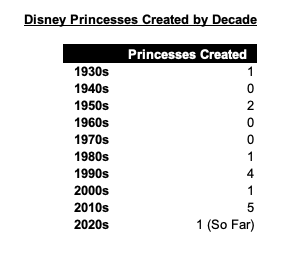(Welcome to the Entertainment Strategy Guy, a newsletter on the entertainment industry and business strategy. I write a weekly Streaming Ratings Report and a regular strategy column, along with occasional deep dives into other topics, like today’s article. Please subscribe.
Today’s article is free for all to read. If you’d like to cross-post it to your newsletter, feel free!)
A few years back, I listened to an NPR Planet Money episode on KFC and their relationship with “Colonel Sanders” the real (and now kinda mythical) founder. Some franchisees believe the company does its best when its branding emphasizes the Colonel.
Listen, I don’t know if that belief would hold up under strict data scrutiny, but I tend to believe that some companies have specific brands and ethos. When they stray from those, they lose their way. For KFC, focusing on the chicken (embodied by Colonel Sanders) means they’re focusing on the right things, even if it is just marketing.
For Disney, that’s princesses.
That’s my argument, at least. When Disney is firing creatively on all cylinders, they’re making iconic characters, and that usually includes creating iconic princesses. After all, it all started with Snow White.
To quantify this, here’s the Disney Princess Creation Index. I published this analysis before, back in 2019, but it’s been five years, so it’s time for an update. The metric is simple: if Disney created one (or more) princesses, it’s a one. If not, zero. Back in 2019, I included anyone who was in the princess scene in Wreck-It Ralph 2, as Disney marketed almost all of those characters as princesses. (Technically, Disney doesn’t count Elsa and Anna as “princesses”, but c’mon.) They all starred in popular movies and were essentially royalty or married royalty. (With the potential exception of Mulan.) Since then, Disney has added one additional princess to the line.
Here’s the five-year rolling average for the last eighty-five years:
To peek behind the curtain, here’s the table of when princesses were created by film:
(Let’s talk edge cases. Mirabel from Encanto has a good case, as her film was absolutely popular enough to count and tons of little girls love to dress up as her or her sister, but as far as I can tell—and yes, Disney has an official coronation for princesses—she is not one. She’s not really from royalty, but we’ll see if Disney changes their mind on that. The surprising one to me was that Disney gave Raya from Raya and the Last Dragon a spot.)
Here’s the count by decade:
Frankly, the index tracks when Disney is rolling (creatively and profitably). Disney started off very strong in the 1930s, but many people forget that the studio struggled to make money/find their next hit film/merchandisable character in the decade that followed Snow White. In the 1980s, Disney was in a rut; by the 1990s, they were on a roll. In the 2000s, Disney had again started slumping, but by the 2010s, Disney Animation again ruled the roost, with Elsa, Anna, Rapunzel, Moana and Merida joining the princesses crew (partially with the help of Pixar, which claims one princess on this list.)
Other Thoughts/Takeaways:
I’ll admit, this is not complicated data analysis! I never said it was. But sometimes simpler is better.
Why look at princesses this week? Well, I was inspired by the upcoming release of Spellbound, Netflix’s latest animated film and their first from Skydance under their deal. And it explicitly involves a princess, though I’ve noticed Netflix has shied from that branding a bit—describing her as the “daughter of the rulers of Lumbria” instead of, you know, “princess”.
If Netflix does have a hit on their hands—and I wouldn’t bet against this one—some of it could be called “The Lasseter Impact”, as John Lasseter—the former head of Pixar, then Disney Animation—is the force behind Spellbound via Skydance Animation.
Disney had an easy opportunity to create the next great princess last year when they released Wish, but that film dramatically underperformed, and for a film set in medieval times, creatively, I think it could have done better if Asha had been an actual princess.
This doesn’t mean Disney won’t have films featuring princesses in the 2020s, with new Frozen and Moana films either releasing or coming soon. But I’d argue, creatively, Disney needs to keep creating new princesses to help reinforce and strengthen their brand.
In a future streaming ratings report, we’ll discuss the release plan for Spellbound, but Netflix chose to launch it the week before Thanksgiving instead of the week of Thanksgiving, likely to avoid Moana 2. Last year, Leo went up against Wish and it did great. I love “release showdowns” like this.
Looking at the other studios, someone once made a similar argument to me about Looney Tunes and Warner Bros. When that studio is clicking, it understands its roots, including the Tunes.
(For those wondering, I don’t plan to start a “visual of the week” for every week, but I’d like to put out these quick hits more often. If you like this style article, let me know! And consider sharing.)





